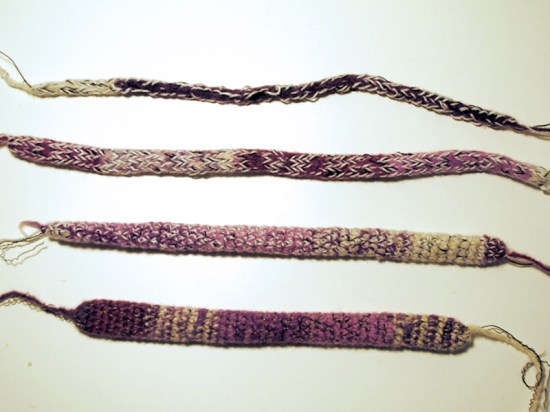Here are a few tests of crochet stretch sensors (and some more knit sensors for comparison) as I try to determine the method that works best for me. I did a few experiments with crocheted vs knit sensors, conductive yarn vs conductive thread, and felted vs non-felted, and using elastic thread to see how each variation of the sensor would compare to the others.
I made a felted crochet stretch sensor following Felted Signal Processing’s Instructable – their method uses elastic thread to help add stretch and regular conductive thread along with wool yarn.
It was a little tricky keeping track of 3 strands while crocheting, and you can see from some of my pictures that I dropped a few stitches in places. I could only find the elastic thread in 11 yard spools, and these sensors (between 11″ and 15″) took about two spools each to complete. This type of sensor took more time and materials than the spool knit samples I made, but had a nice solid feel to it.
I was interested to see how felting the conductive yarn and knitted sensors would compare with the original sensor trials I had done, so I made a few more with variations. Here are the sensors before felting (from top to bottom):
A: Knitted sensor on 3 pin Wonder Knitter w/ elastic thread, wool yarn, and conductive yarn
B: Knitted sensor on 6 pin Wonder Knitter w/ elastic thread, wool yarn, and conductive yarn
C: Crochet sensor w/ elastic thread, wool yarn, and conductive yarn
D: Crochet sensor w/ elastic thread, wool yarn, and conductive thread
Here’s a side by side comparison of a felted sensor and the others ready for felting.
And all the finished sensors.
So how did they compare? Here is a chart of my results:
| Sensor | Resting Length | Resting Resistance | Stretched Length | Stretched Resistance |
|---|---|---|---|---|
| A | 15″ | 2.5 M ohm | 20″ | 12 K ohm |
| A (felted) | 12.5″ | >20 M ohm | 14.5″ | 3 M ohm |
| B | 17″ | 3.3 M ohm | 22.5″ | 4 K ohm |
| B (felted) | 13″ | >20 M ohm | 15″ | 2 M ohm |
| C | 11.5″ | 2.8 K ohm | 13″ | 1.2 K ohm |
| C (felted) | 10″ | 1.7 M ohm | 13″ | 1.3 M ohm |
| D | 11″ | 20 ohm | 13″ | 15 ohm |
| D (felted) | 9.5″ | 38.5 ohm | 11″ | 35 ohm |
The crochet sensors, while nice and sturdy, weren’t really all that stretchy. I also noticed that they didn’t bounce back, and over time would stretch longer and longer. Maybe a different type of elastic would help with this issue.
The conductive thread sensors also need to be very long in order to get a large range of values, so I think the knit sensors with conductive yarn will be the way to go for hooking up to a drawdio.




